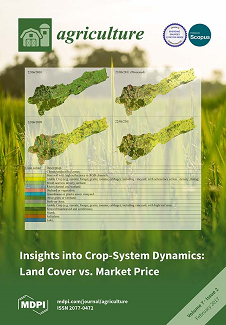Nitrous oxide (N
2O) emissions from agricultural fields are an important source of the increasing atmospheric N
2O concentration. We conducted a two-year investigation of soil N
2O emissions induced by the application of combined organic and synthetic fertilizer (COS)
[...] Read more.
Nitrous oxide (N
2O) emissions from agricultural fields are an important source of the increasing atmospheric N
2O concentration. We conducted a two-year investigation of soil N
2O emissions induced by the application of combined organic and synthetic fertilizer (COS) and distilled silage waste (DSW). Three experimental treatments were applied to a
Citrus unshiu field in January 2013 in Ehime, Japan: no fertilizer (NF), COS, and DSW. The applied nitrogen (N) from DSW was 192 and 244 kg N ha
−1 in the first and second years, respectively, although the N application in COS was 192 kg N ha
−1 in both years. The main N forms in COS and DSW were ammonium- and nitrate-N, respectively. Soil N
2O and carbon dioxide fluxes, soil chemical properties, and mineral N leaching from topsoil were measured. The soil N
2O flux increased after fertilization in COS and DSW, and a higher N
2O efflux after supplemental fertilization was induced by warm and wet soil conditions. The emission factor of N
2O was higher in COS (2.02%) than in DSW (1.18%), while N leaching was higher in DSW than in COS. The organic materials remaining after the application possibly increased the N
2O emissions in the summer season. Therefore, to mitigate N
2O emissions in citrus orchards, fertilizer containing organic materials should be applied during a cool and dry season.
Full article





